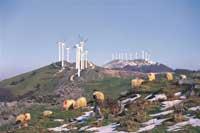Winning thesis on the wind turbine control system

The work of Haritza Camblong has won with 480 votes the first thesis contest organized by the portal Basque Research. Second from list M. Aranzazu de Zarraga has been a chemist with 288 votes. The third prize went to the thesis on materials by Pello Uranga Zuaznabar, with 273 votes.
A total of 35 people have participated in the thesis contest and the topics have been diverse: chemistry, materials, genetics, engineering, environment, energy, physics, medicine, fishing, acoustics, computer science... However, most research has focused on energy and engineering.
Increased control of wind turbines
Camblong oak has completed his thesis in three universities: At the Polytechnic School of Mondragon Unibertsitatea, at the School of Bordeaux of ENSAM and at the ESTIA University of Bidarte. The work has ended and will be defended before the jury on December 18. Thesis title: Reducing the impact of wind disturbances on electricity generation using variable speed wind turbines.
Research conducted by Haritza has focused on improving the wind turbine control system. Specifically, he has worked with variable speed wind turbines, increasingly used compared to fixed turbines, including the pitch control system to modify the tilt of the wind turbine blades. The aim of the thesis was to design control laws for these wind turbines.
According to engineer Haritza Camblong, wind energy is developing dramatically in recent years mainly due to the harmful effects on the environment of traditional energy sources and the latest advances in wind turbines.

Wind energy has great advantages: it is clean and renewable and, as the wind blows everywhere, it is widespread. However, it also has less positive aspects: it is not continuous (sometimes there is no wind) and it is difficult to accumulate. On the other hand, erosion, damage to the fauna and flora or land affected by the construction of wind turbines must be taken into account. And its impact on the landscape.
The impact does not only affect the landscape. Wind energy increasingly affects the power grid. In fact, in windy areas, an increasing share of the power of the grid comes from wind generators. This generates major disturbances in the power grid that need to be controlled.
In order to carry out these changes, Camblong believes closer control of wind generators is essential. This control must also be carried out taking into account the totality of the wind generator, that is, the disturbances produced by the wind.
And that has been the core of Camblong's thesis. Design the control laws of variable speed wind turbines and pitch control system, including wind disturbance. For the design of these systems, in addition to taking into account wind disturbances, it has considered four other optimization criteria: quality of the electrical energy generated, energy performance, improvement of the solidity of the control laws and reduction of mechanical coupling loads between the turbine and the generator.
Presents simulation models
The Camblong oak has presented in his thesis the simulation model of a variable speed wind turbine and pitch control system, analyzing mainly the behavior of wind and turbine. This simulation has been contrasted with the actual data of a 180 kW wind turbine and the information appeared in several magazines.
The analysis was carried out taking into account the three operating areas of the wind turbines, with medium speed winds, strong or very strong. In addition to the different control of the wind turbine in these three zones, the electric power generated by the wind turbine is not directly proportional to the wind speed. Therefore, the system is not linear and cannot be represented by simple functions or models.

To analyze the behaviors of this nonlinear system, from the simulation model, Haritza has obtained linear models for different operating points. Consequently, it has been able to design robust numerical regulators for each operating area. Finally, the researcher has tested these control laws in a nonlinear simulation model.
For oak, simulation models are useful for the study of control laws, but these laws should be tested in a test bench before being integrated into a real wind generator. Thus, he tested the simulated generator on a 15 kW bench and conducted a series of experimental tests.
Taking into account the results obtained in simulations and test benches, the Oak study concludes that advanced control laws can improve the behavior of wind generators.
www.ihobe.net





